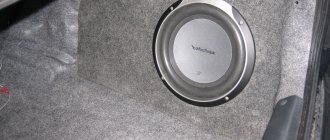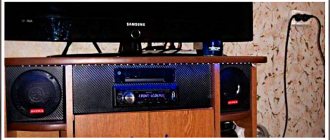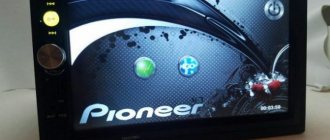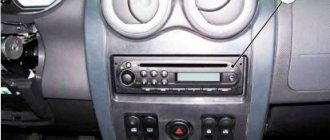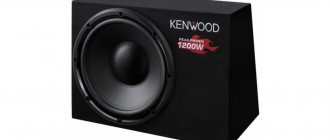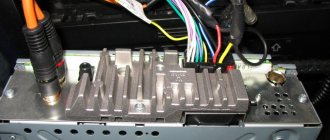Articles
- 2 Criteria for selecting an amplifier
- 3 Which amplifier to choose if a subwoofer is installed
- 4 Sound noise
4.1 What you need to connect
- 4.2 Connecting the amplifier
How to connect an amplifier and subwoofer to a car radio
Many car owners are well aware of how expensive it is to equip them with various accessories and maintain them. Some, in order to save money, and others, out of love for technology, try to do everything with their own hands that does not require the use of special expensive equipment. The instructions and videos on the pages of our website will tell you how to connect a subwoofer and amplifier to a car radio. This is the question readers ask most often.
Types of subwoofers
Car woofers equipped with a custom housing can have a built-in amplifier or are connected directly to the car radio.
The use of an additional amplifier allows you to relieve the head unit. To perform adjustments across frequency ranges and match the signal with other acoustic devices, a separate crossover is placed. The subwoofer volume is adjusted using a separate rotary potentiometer mounted on the body of the product. The design has a special bass reflex, which provides expansion of the frequency range due to the resonance effect. There are designs of low-frequency devices in which the loudspeaker is placed on a dividing partition inside the housing.
The passive subwoofer is connected through the rear speaker connectors or to special plugs located on the head unit. Such a switching scheme increases the load on the electronics of the radio and negatively affects the operation of the components of the car's acoustic system. But since equipment without an amplifier has a low price, car owners are interested in the question of whether it is possible to connect a subwoofer while minimizing loss of sound quality.
The main differences between passive and active subwoofers
To answer the question about the distinctive aspects of active and passive subwoofers, you must first understand what each of the designs is individually.
What is a passive subwoofer
A passive sub is a design of one or more low-frequency (LF) dynamic drivers enclosed in a single housing, the material of which can be either plywood or wood. In order for such a device to reproduce sound vibrations, it is necessary to connect to an external audio amplifier through a low-pass filter, which passes only the signal band with low frequencies.
A passive subwoofer is a separate unit of speakers, filters and amplifier. Each of these blocks is purchased separately and connected to each other during installation.
What is active
An active sub is a single ready-made acoustic unit, consisting not only of a speaker and a filter, but also an amplification device. Such equipment is somewhat simpler to connect, and there is also an opinion that the sound quality is superior to the sound from a passive subwoofer. But if you look in more detail, the sound quality directly depends on how the settings are made.
The active subwoofer has a built-in amplifier, which saves space in cars with little free space. To connect to the radio, you only need to supply power and an audio signal.
Difference between them
To decide which design to give preference to, it is worth considering the main points that car owners pay attention to when choosing:
- Price indicator - the cost of an active subwoofer is higher, which is due to the presence of an amplifier and other expensive elements in the device.
- Advantages of installation - passive structures are more difficult to install due to the need to additionally install a filter and amplifier. The presence of an amplifier in the active system saves space, which is especially important for small cars.
- Sound quality - Many would argue that the sound of an active system should be better. However, the sound directly depends on the correct setup of the system. Based on practice, with high-quality setup of a passive subwoofer, the sound surpasses the performance of the active system.
- Ease of setup - an active speaker system has more advanced setup options, but if a good external amplifier is used, then this feature is negated.
Pros and cons of systems
The positive aspects of a passive subwoofer include its relatively low cost due to the lack of a built-in amplifier. In addition to this point, the use of passive systems allows you to assemble an acoustic device with exactly the requirements that will correspond to high-quality sound as you understand it. In order to get a subwoofer with optimal sound quality, you will need to select an amplifier, frequency filters, and a set of dynamic drivers in boxes. Compared to active ones, different types of enclosures are used for passive designs: bandpass, bass reflex, and standard boxes. As for active devices, it is difficult to use different types of housings due to the need to accommodate additional electronics.
The main advantage of active is the presence of a built-in amplifier and filter, which allows you to connect the system to a car radio without additional devices. This positive feature is also a disadvantage. Due to the fact that both the speaker and electronics are located in one case, something has to be sacrificed. The main caveat is the insufficient power of the amplifier.
What you will need
How to connect a radio
To install a passive subwoofer without an amplifier on your own you will need:
- speaker cables required for switching;
- plastic buffers to hold the woofer housing in the luggage compartment of the car;
- plastic screwdriver for removing plastic interior trim;
- side cutters for cutting cables;
- plugs needed for connection;
- PVC tape or protective tube;
- flexible clamps;
- protective corrugated tube for laying cables.
Before starting installation work, you should make sure that the purchased equipment is compatible. Connecting speakers with inappropriate coil resistance causes the radio amplifier to overload, which damages the device. If the player has a security code, you need to make sure it is there. Otherwise, after connecting the battery to the on-board network, it will not be possible to restore the radio’s functionality.
Assembly and connection
How to connect a standard and non-standard radio in a car
There are several types of subwoofers, and each of them can be assembled with your own hands, installed yourself, or, of course, you can buy a ready-made one. There is nothing complicated in self-assembly and you can ultimately achieve good results by solving an interesting problem and using extra parts lying around. It is much easier, of course, to buy a ready-made one and connect it without outside help. Connecting yourself will help you save a significant amount. Connecting a subwoofer carries the risk of damaging the interior trim. The car may be damaged. There are no more risks. The wires must be hidden. In general, wires come in different colors, but in any case they will be noticeable.
Selection of cables and wires
Which subwoofer for a car is better, active or passive?
The wires for the speaker system in the car are multi-core cables that transmit sound signals from the head unit or amplifier to the subwoofer. They play no less important role than the equipment itself. However, choosing the right option is not always easy. The cables presented in specialized stores differ in cross-section, core material, insulation and cost.
According to their purpose, cables for car audio come in 2 types:
- acoustic (such products are required to transmit a signal from the amplifier to the speakers);
- interconnect (they are needed to transport low-voltage signals from the radio to the amplifier).
The first piece of advice that professionals recommend following concerns the price category of the product. Thus, a cheap cable for connecting a subwoofer should not be purchased for expensive equipment, since the quality of the reproduced sound will deteriorate. At the same time, buying expensive wires for budget acoustics will be a waste of money.
Depending on the core material, wire sets come in several types:
- Copper. They, in turn, are divided into those made of rough copper and oxygen-free copper (OFC). In the first case, the products are basic and have a relatively low price. The base made of oxygen-free copper allows you to increase the conductivity of the cable, but the cost of the product will be an order of magnitude higher. Another copper wire is PCOCC, in which the base is made of pure copper.
- Copper-plated aluminum. This is another inexpensive wire option. Among the list of disadvantages of such a product, professionals name increased fragility and brittleness.
- Silver plated or silver. Such products for connecting a subwoofer to a receiver have high performance and durability, but are much more expensive.
Home amplifier from car
If not, there is a way out. Well, let's go: So, let's find out first of all what types of car subwoofers there are: 1 Active subwoofer. If you have a tester and you also know how to use it, then I think there is no need to say anything further, I’m sure you already know without me that you can measure the voltage at the output, and only then connect the sub - everything is really simple, but who doesn’t knows how to learn to work with devices in life it will be useful to measure the same battery, especially since a simple tester is not that expensive, literally a couple of thousand tenge Connecting a passive car subwoofer. In the absence of an amplifier, a passive subwoofer is connected to the front speakers.
Judging by the characteristics of the cheapest models that are now sold in stores, this is 12A. In this case, the amplifier is connected to the speakers, see
As you know, car radios have a special output, usually blue. Connect two pieces of cord to two terminals; 4. We also end the ring one on the car body, and the y-shaped one on the amplifier.
If you buy a good subwoofer but connect the subwoofer with thin wires, it will “fart”; it simply will not produce bass, this is explained by monstrous power drawdowns, the power supply on board the machine’s network drops from normal 14 Volts to Volts on the primary, on the secondary of the amplifier converter there are also drawdowns accordingly power and quality are lost. After completing the above procedures, all that remains is to connect the wires that transmit the sound signal from the amplifier to the subwoofer; the sound after amplification has greater power, so the cross-section of the wires must be appropriate. The passive one does not have a built-in amplifier - that’s why it’s called passive.
It has connectors for connecting a subwoofer. For them we set the mode to OFF. How to connect a car amplifier
Wires for subwoofer
The positive power wire is laid from the battery terminal and connected through a fuse.
You can draw the negative power wire from any metal bolt that is screwed to the car body. The recommended cross-section for the positive power wire is about six to eight square millimeters. Such a large cable diameter is explained by the high current consumption. Do not forget about the need to use a fuse that will protect the circuit from overload and short circuit. This fuse should be installed under the hood as close to the battery as possible. The second negative power wire, also called the ground wire, is screwed to the body at any convenient point. As a rule, its connection is made directly next to the installed subwoofer. This power wire is connected to the (-) terminal or to the terminal marked GND.
If your standard radio has separate connectors necessary for connecting an active type of subwoofer, then such switching is carried out without any difficulties. From the radio it is necessary to lay a coaxial shielded signal cable, which has corresponding connectors for connecting a subwoofer. On one side, this cable is connected to the radio in the SubOut connector, and in the subwoofer it is connected to the LFE or LineIn connector.
In cases where there is no corresponding output on the radio, you need to use an additional converter that allows you to transform the signal. The converter is connected to the output of the main speaker system.
This will allow us to obtain a linear standard signal at the output of the converter. Subsequently, such a linear signal is supplied to the corresponding subwoofer outputs. The connection is made using the same signal wires as in the first case if there is a subwoofer output.
To ensure the required sound quality, signal and cable products must be selected from professional manufacturers. The choice in specialized stores is extremely wide. We can recommend that you use cables from the following manufacturers - Profigold, Kimber Cable, Ost, Monster Cable. But what we wouldn’t recommend you do is buy a cheap Chinese cable.
It is quite possible that the cost of such a cable will seem attractive to you, but its quality is at a mediocre level, and you will not receive any return from the installed subwoofer. When performing installation work, the following rules must be observed. The cable is laid using the shortest route. Avoid sharp bends in the cable. When passing the cable through metal elements, rubber bushings should be used to protect the cable from chafing by metal.
These installation instructions will allow you to do all the work yourself and will significantly improve the sound quality of the standard stereo system in your car.
Connecting the positive cable
Clean the ends of the power cable and install the terminals. The shape and size of the terminals are selected according to the shape of the connectors where you will connect them. And also take into account the cable cross-section.
The terminals are crimped. You can crimp with regular pliers. With the exception of special ones, which require the presence of pliers with jaws of a certain shape. But it’s hardly worth buying these for one-time use.
An example of connecting the power cable for a subwoofer to a battery
So, we placed the bare conductor in the terminal so that there were several millimeters of insulation in the grip. That is, when you crimp the terminal, the bare wire should not peek out from under the terminal. If you have a soldering iron, it is better to solder the wire to the pad and then crimp it. But the conditions are the same - bare wires do not stick out from under the terminal.
Selecting a fuse rating for connecting 12 V to a subwoofer (or amplifier)
Then, at a distance of 15–20 cm from the edge that you will connect to the battery, make a cut and install the fuse. Take a fuse for 12 V, and for the current that is supposed to pass. For an active subwoofer it is selected depending on the power, if not specified or not included.
We pull the cable into the cabin through the standard hole in the bulkhead. It must be protected with a plastic or rubber pad. We monitor its condition and the condition of the insulation of the wires that are already there. We pull the cable around the cabin so that it is unlikely to be damaged. It's best in the center of the cabin.
We fasten it with plastic clamps and fix it often, especially in places of turns. But it’s better to postpone fixing until you’ve also laid out the speaker wires. They will have to be pulled from the radio also to the amplifier or subwoofer.
How to connect a subwoofer to an amplifier
Single channel connection
Connecting a subwoofer to an amplifier is not difficult; just connect the amplifier's audio output jack to the subwoofer coil or coils using speaker wires.
The wires should not be thin. In most cases, choose copper wiring with a cross-section of 4 mm and there will be no problems.
Connecting speaker wires
This subwoofer connection diagram is suitable for one channel of an amplifier or monoblock.
Connecting to a subwoofer via terminal block
Connecting to a subwoofer directly
Connecting a subwoofer with a bridge
In the case of using a multi-channel amplifier, the sub can be connected to two channels simultaneously, using the minus of one and the plus of the other, this connection is called bridged, with this method the power output by the amplifier increases significantly (see the specifications for specific numbers).
So you can connect a subwoofer to a two or four channel amplifier, using 2 channels for acoustics, and the remaining 2 for the subwoofer.
To connect a subwoofer with a bridge, make sure that your amplifier supports this feature.
If you connect a low-frequency speaker to an amplifier by changing the polarity, that is, connect the plus of the subwoofer to the minus of the amplifier output and vice versa, then the speaker will work in antiphase, there is nothing wrong with that, sometimes such a connection is used intentionally if the amplifier does not have phase adjustment (more about adjustment phases).
Connecting the subwoofer coils
The technical documentation for the subwoofer states the resistance of its coils (1 Ohm, 2 Ohm, 4 Ohm, rarely 0.5 Ohm), and the technical documentation for the amplifier indicates what resistance it can work with, this information is needed so that you connect correctly and effectively subwoofer to amplifier. The lower the resistance of the sub, the more power the amplifier will produce, provided that it can operate at this resistance. A subwoofer speaker may have several coils (1 or 2, rarely 4).
When the coils are connected in series, the resistance increases, while in parallel it decreases. If you don't want to learn definitions and count fractions, just save this cheat sheet (parallel and serial connections).
Connection options
How much ohm to connect the subwoofer
The higher the resistance, the better the sound quality; the lower, the more power the amplifier delivers. If you need a lot of loud bass, then turn it to the minimum that the amplifier can provide, and if the overall sound quality of the system comes first, then it is 2 Ohms or 4 Ohms, depending on the power output.
Video on how to connect 2 subwoofers or more. Subwoofer connection diagram 2x2 Ohm, 4x4 Ohm, 1x1 Ohm. Serial connection of speakers. Parallel connection of speakers. Basic principles.
Happy connections!
Why do you need an amplifier?
Multimedia head units have a built-in amplifier, which is not suitable for all car owners. Installing additional equipment allows you to clear the signal of interference and install additional speakers that improve the reproduction of low or high frequencies. When using an additional amplifier, the power of the generator and the capacity of the battery should be taken into account; to reduce the likelihood of voltage failure, electrolytic capacitors (storage) are used.
How to calculate power and choose
To select the equipment yourself, you need to calculate the power of the loudspeakers installed in the circuit of each channel. Based on the obtained values, an external signal amplification device is selected. It is recommended to purchase a more powerful device (10-15%) to reduce the load on the equipment and allow you to subsequently replace the acoustics. You should also take into account the resistance of the coils in the speakers and the frequency range for which the products are designed.
The choice of type of amplification machine installation depends on the configuration of the future speaker system. If you plan to connect a subwoofer to an amplifier, a device with 2 channels that are connected via a bridge circuit is sufficient. If the reason for the modification is the desire to get rid of noise in the speakers and increase the sound volume, you need to purchase a 4-channel unit. To use 4 speakers and a subwoofer at the same time, you will need to install a 5-channel amplifier or use 2 separate devices.
To connect the car amplifier to the radio, “tulip” or RCA connectors are used, located on the rear wall of the head unit housing. Before purchasing an external device, it is recommended to check the type of outputs used on the player. If there are no connectors, it is possible to switch the amplifier unit to standard acoustic outputs through a signal amplitude reduction module (attenuator).
Instructions for connecting the Mystery passive subwoofer to the Pioneer radio
The schematic diagram of low-frequency speakers of both active and passive types is almost the same, with the exception of small additions related to non-active subwoofers.
For this reason, we will analyze the general method and then make changes.
The process of turning on a car radio with a passive subwoofer is very simple: it is connected directly to the amplifier, which, in turn, is connected in series to the car player.
The role of the standard amplifier in this circuit is to transmit the signal received from the sound of the playback device (car radio) to speakers with high and low resolution frequencies. Where the subwoofer itself acts as a converter of low-frequency signals, and its satellites act as a converter of high-frequency signals.
Due to its rather large dimensions, the installation of the subwoofer is carried out mainly in the luggage compartment of the car and the power supply wires have to be pulled through the entire cabin to the battery. Which does not improve its (interior) appearance.
Not active subwoofer
You can connect a passive subwoofer to a radio without an amplifier in 4 steps.
- Through the technological hole in the engine compartment we stretch the supply wire to the battery. We install a fuse on the positive (plus) wire closer to the battery.
- We pull the wiring into the cabin and stretch it to the trunk, if possible disguising it under the interior trim parts.
- We insert the wires through the finished technical hole (if necessary, we make it ourselves) into the trunk of the car. And we connect directly to the low-frequency speaker, according to the diagram (on, to -).
Connecting the subwoofer to the Pioneer radio via a single-core power (blue) wire and a wire with tulip connectors
Classification of subwoofers and methods of installing them in a car
Connecting an active subwoofer One of the common ways to connect an active subwoofer is the following sequence of actions: Power and signal wires are used to install the subwoofer. At the end of this article you will find a diagram for connecting the subwoofer to the standard radio and amplifier, as well as video instructions on how to properly install and connect the subwoofer in the car yourself.
However, such devices are not very powerful. Connection diagram for a passive subwoofer in a car Connecting a passive subwoofer in a car is somewhat more complicated, since it needs to be connected not directly to the radio, but through an amplifier, see the connection diagram above. We lay the wiring in the engine compartment in the standard wiring harness and bring it out into the cabin. The amplifier is used to increase the volume headroom, reduce distortion and improve the sound quality of music. As a result, such a good quality kit turns out to be more expensive than a ready-made active sub. To prevent the cable from fraying, it is better to insert a rubber bushing, for example, a piece of hose. Only high-quality wires are used for installation.
Since the wires will have to be pulled through the interior, in order to avoid chafing of the cable, it is better to use corrugated sleeves, which must be securely fastened to the cable connection points. To connect a passive crossover, it is placed directly in front of the load, i.e. Crossovers are of active and passive types, as well as one- and two-way.
Classification of subwoofers and methods of installing them in a car
Using a converter involves connecting the main speakers through an amplifier. Let us also add that any work on connecting electrical equipment in a car must be carried out by removing the terminals from the battery.
To which the seller offered me a more budget-friendly option. However, it also happens that an amplifier or active subwoofer does not have such an input.
The wires should not be thin. The subwoofer's subwoofer bass and front bass are enhanced or sounded quieter by different sized speakers. Subwoofer lighting It is better to do the lighting for the subwoofer speaker at the stage of manufacturing the box. How to connect a subwoofer and amplifier. Fast and clear.
Where to install
For some motorists, installing acoustic equipment can be a big problem. The matter concerns both the size of the device itself and the car model.
Hatchback and minivan. In cars with this type of body, you can easily find space even to accommodate a large system. This is explained by the good trunk capacity.
Sedans. The trunk in sedans has a smaller volume, so there is not always room there to install a subwoofer. The problem can be solved by installing speakers in the armrests or on the rear shelf.
Cabriolet. In such a body, it is most difficult to connect a subwoofer to the car, since space is at a premium here. In this case, it is better to choose bandpass type acoustics or FC cabinets equipped with a bass reflex.
Types of subwoofers
DIY subwoofer installation diagram
First, a little about the product itself. A subwoofer is a speaker that produces low-frequency sound (bass). There are two types:
- Passive;
- Active;
Sub in the case
In the first case, the design consists of 1-3 speakers installed in a wooden case. Many people are interested in how to make a passive subwoofer? - very simple. To do this, you only need a pair of low-frequency speakers, for which the housing should be made of wood. The disadvantage of this product is that its power is high and for normal operation it will require the installation of an amplifier. Will the subwoofer work without an amplifier? - of course, this is an ordinary speaker, but its sound will leave the best (you won’t be able to get loud and clear bass with this connection).
subwoofer without housing
Active subwoofers differ in that they already have an integrated amplifier and can be directly connected to the radio.
Some radios may also have amplifiers in their design, which allows you to connect woofers directly, without additional equipment. But before you connect it to a standard radio, you should make sure that the parameters of its amplifier are higher than those of the subwoofer.
Where to connect the wires on the amplifier, radio or subwoofer
On the back of the radio or amplifier there are usually two separate ports - for connecting the power part and acoustics. There may be connectors of different shapes. Terminals for bolted connections are more reliable; in them, the wires are attracted by bolts with contact pads put on them. They need to be tightened periodically so that they do not become loose from shaking.
Example of connection to an amplifier. Same thing for the radio
We connect the cable from the battery to the terminal labeled +12 V. The negative is connected to GND or “–”. There is another terminal in the power block - RMT or can also be labeled as REM. This is the input for connecting the control cable. It serves to simultaneously turn on the amplifier and radio.
Connecting power cables to an active subwoofer
The subwoofer has a similar connector for connecting power cables. In the photo on the left he is below. There is the same input, labeled +12 V. We connect the cable from the battery here. The GND socket is the negative from the case, and the REM socket is for connecting control. As you can see, the power on all active parts of the system (radio, amplifier and subwoofer) is connected in the same way.
How to setup
Correctly setting up the subwoofer allows you to make the most of all the capabilities of the speaker system in your car. Some music lovers still use factory settings, but this can greatly affect the sound quality. This feature is explained by the fact that the manufacturer cannot take into account the preferences of each listener. In addition, the quality of the reproduced sounds is greatly influenced by the type of car body and the installation features of the subwoofer.
Inaccuracies when connecting the subwoofer to the standard radio and setting up the system cause resonance in the car and rattling of individual elements of the plastic trim. To correct the sound, experts suggest using a specialized disc. It can be found in auto stores. This disc contains musical compositions with which you can fine-tune the settings.
Active subwoofer
To properly set up an active subwoofer in a car, you need to go through several stages of work. The stages of work are similar for any type of connection (to a monoblock or through amplifiers).
First of all, turn on the low-pass filter. It can be located on the radio itself or on the amplifier. The filter can be called as follows: Low Pass Filter (abbreviated LPF), as well as LF or low-pass filter. This action is necessary to minimize the sound of mid and high frequencies. When the filter is turned on, only bass will be heard.
Initial volume and frequency settings. Before you properly configure the sub, you need to find the filter frequency control - it is located on the amplifier and marked Frequency. Its indicator should be at around 80 Hz. The sensitivity control can be recognized by the inscription Gain or Level. Its level must correspond to that of other regulators.
Switching polarity. Only the fact in which direction the speaker cone will begin to move depends on the specific connection. In order to adjust the parameter, you need music in which the bass is reproduced clearly and clearly. After this, you need to find a sound option in which the subwoofer will produce sounds that are indistinguishable from the sounds from other elements of the speaker system.
The next task is to adjust the subsonic. This name refers to a subtonal filter that cleans musical compositions from excessively low sounds. In most cases, a level of 20 Hz will be sufficient. Those who prefer the loudest bass possible may need a level of 40 Hz.
It is equally important to configure the subwoofer taking into account mid-bass performance. This again requires volume control and a low-pass filter.
If you need soft bass, set the volume higher and the filter lower.
Passive subwoofer
Some buyers think about adjusting the radio for the subwoofer at the stage of choosing a speaker system. At the same time, there is an opinion that an active subwoofer is simpler and more convenient to operate, install and configure. This is not entirely true.
The advantage of active devices is simple, quick installation. Meanwhile, the absence of a separate amplifier for the subwoofer in the car reduces possible adjustment modifications.
Ready-made factory kits somewhat limit the buyer’s choice. You won’t be able to buy a powerful, high-quality product for relatively low prices. Well-equipped devices require large investments. To purchase an active subwoofer for a car, in some cases you will have to make concessions on certain parameters.
The highest quality and most flexible connection settings are those devices that were made to order. In these cases, you can make a parallel-connected subwoofer and make the most fine-tuning of the radio, subwoofer and other individual components of the system.
How to calculate the required audio system power
A preliminary calculation of the power of the audio system will help you choose the right power cable and other necessary components. Here you will need to know the exact rated power of the installed amplifiers. The parameters can be found on the Internet for a specific amplifier model or in the instructions for the device. If a separate speaker amplifier is integrated, its power should also be taken into account.
The indicators should be added together, thus obtaining the power of the system. The power wire will need to be selected taking into account the obtained value. If a motorist plans to install higher-power speakers in the future, it is better to immediately select a cable with a reserve.
CORRECTLY CONNECTING A SUBWOOFER TO AN AMPLIFIER
The subwoofer is connected to the amplifier using a car audio converter (adapter, adapter). This is a small device with a pair of RCA outputs and two pairs of wires, two of which are used to connect a dynamic emitter. The rest of the wires can simply be hidden - they are not needed for now. The line output wires (RCA OUT) must be connected to the amplifier.
The principle of connecting a subwoofer to a single-channel amplifier
To connect a car subwoofer to a mono amplifier, you will need to connect the positive and negative voltage wires from the amplifier to the same terminals of the subwoofer - that's all. Connecting several passive subwoofers is a little more complicated. Their connection is carried out in a parallel or series circuit, but with the obligatory precise calculation of their internal resistance.
The principle of connecting a subwoofer to a two-channel amplifier
In this option, the connection is made using a bridge circuit. This connection technology works great with virtually all two-channel amplifiers, to which you need to add another subwoofer. Here, too, everything is simple - we take the positive wire from one channel, and the negative wire from the 2nd channel and feed it to the corresponding terminals of the subwoofer.
When making this connection, special attention should be paid to the internal resistance of the subwoofer, which should be 4 ohms. In addition, you should take into account that with this option, the output power of both channels is added
If the amplifier has the function of switching mono and stereo modes, then in this case the wires are connected to the positive and negative terminals of one channel. If there is a need to connect two subwoofers to the amplifier, then the speaker cable from them is fed to different channels.
For correct and clear operation of the subwoofer, you should provide an LPF low-pass filter, which will set the upper limit of the low frequency.
The principle of connecting a subwoofer to a four-channel amplifier
The standard connection of a speaker system to a four-channel amplifier is considered to be a scheme with two speakers and one subwoofer.
So, the typical way to connect an audio system to an amplifier would be the option of two speakers and a subwoofer. In this case, the sub is connected to the amplifier via a bridge circuit, and the audio speakers are each connected to their own channel. The peculiarity of this connection is that the speakers must work with the front channels, and the sub with the rear ones. But at the same time, it is possible to connect a pair of subwoofers to different rear channels.
Connection errors
An incorrectly installed audio system not only produces poor sound, but can lead to failure of the head unit, power surges in the on-board network, blown fuses, blown electrical appliances, short circuits and damage to the wiring.
List of common mistakes:
- An overpowered amplifier will damage the woofer. The main selection rule, which reveals the full sound potential of a subwoofer: the power of the amplifier should be less than the declared peak loads of the woofer. You can correctly calculate the amplifier rating using the formula: U – the voltage value of the vehicle’s on-board network with the engine running and powered by the generator = 14.4 Volts;
- I – nominal value of the fuse, or their total value in the case of several separate channels;
- Efficiency (efficiency factor) – constant value: class AB subwoofers – 50% (0.5), class D – 75% (0.75);
- n – number of independent channels of the device.
An amplifier with reduced power - the sensitivity range drops, the subwoofer cannot be “boosted,” and instead of a distinct bass, a background hum is heard. Incompatible radio and bass speaker parameters. If the head unit has a “Sub Out” pin, then the power is calculated using a similar formula as for an amplifier. The rating of the fuses in the system does not correspond to the peak load: if their value in Amperes is lower than necessary, then burnout will occur even at low powers. If the resistance is too strong, voltage surges in the on-board network and overheating of the electrical wiring occur. Incorrectly set polarity on the line outputs - the subwoofer does not turn on. Power and speaker cables do not correspond to network parameters - poor sound quality. Incorrect crossover or equalizer settings.
After installing the subwoofer into the speaker system, adjusting the low frequencies is carried out using a digital equalizer, bringing the speakers to peak loads. Modern devices have a wide range of capabilities and a range of different functions for adjustments (for example, bass boost adjustment, “Bass Boost”, noise reduction mode). Sound correction should be done carefully, not exceeding the signal level by 3 dB. It should be remembered that the increase in power to the woofer occurs multiple times: if you set the bass boost to +10 dB, then the power to the linear input register will be 14 times higher, resulting in overload, fuses blowing, and system components failing.
Four main types
The main types of subwoofers are:
- open;
- hull;
- active;
- passive.
An open subwoofer is the first option. It needs to be built into any of the car panels. This is a smart option for anyone who doesn't like to fiddle around for too long. There is a second option - case-based. It will have to be built into a special box. The calculation here must be accurate. This box increases the sound pressure on the speaker. The speakers are 100% engaged. With its help you can slightly adjust the sound.
There is also a distinction between passive and active. Passive is simple. It lacks an amplifier and crossover. It must be connected in parallel with other speakers. You can make a crossover yourself and include it in the system. But it’s easier to immediately install an active subwoofer, which has both an amplifier and a crossover. Connecting an active subwoofer to your car will solve many problems at once.
In addition, a passive subwoofer sometimes causes a quieter sound from the speaker system, which must be taken into account when making a decision. Active will give good volume. An amplifier and crossover simplify the wiring diagram. It is easier to install an active subwoofer with your own hands without experience, although some may disagree with this point of view.
The amplifier and crossover are important elements. Think about the available options, compare them with the final goal, which is drawn in the mind - rationally. If there is no time or desire to choose or think, in the worst case, an extra part may appear in stock, which is also not a disaster. The supplier or seller, alas, is not obliged to accept back the purchased item if there is no receipt, damage appears, and so on. The money spent could have been invested in something else, but you can always sell speakers, microphones, subwoofers to someone who really needs them. This will allow you to return most of the amount.
Power cable for active subwoofer
To supply power to the subwoofer, you must pull the cable from the battery. You should not connect it to the cigarette lighter, turns, locks and other devices. And the sound will be bad, and the safety will be low.
Acoustics are one of the most powerful consumers and the cable is needed from the power category. Well insulated, with a large cross-section and made of good copper. The cross section is selected depending on the power of the column. Let's say right away that it will be considerable.
Table for determining the cable cross-section for connecting the power supply to an active subwoofer
The table shows the recommended diameter depending on the power of the connected device. Dimensions are given in AWG - the American system for measuring wire cross-section. This is the first number. The correspondence in square millimeters - mm², which is accepted in our country, is given in brackets.
You will not find an exact match on our market. For example, 6.5 mm² is definitely not. Available in 6.0 mm² or 8.0 mm². It is better to take the nearest larger one. That is, if you need 6.5 mm², then it is better to take 8 than 6.
Cables for power supply to active subwoofer
Take the length with reserve. Splicing of power cables is not permitted. If it turns out to be short, you will have to pull a new piece. You will also need terminals, which you attach along the edges of the cable. Preferably copper ones, made of thick, good copper. Ideal - tinned (white, but copper inside). They oxidize less.
Technical issues
With an amplifier, the car audio system has higher power consumption. If with a conventional car radio the consumption is about 10 A, then when installing a subwoofer with an amplifier it can be up to 60 A. This must be taken into account when choosing equipment and when connecting the radio. When choosing, take a radio/amplifier of higher power (and with 4 channels); when connecting, take wires of a larger cross-section.
Set for connecting a subwoofer amplifier: two power cables, interconnect, control and acoustic
If your radio is connected normally, and you decide to add a subwoofer, it is better to replace the power wire with a thicker one. And the sound will be better (you can check), and the wires will heat up less. And you probably know what heating up the wiring in a car leads to.
When choosing a cable cross-section for supplying power to the amplifier, the total (total) power of the amplifier must be taken into account. It depends on the number of channels and the power it delivers to the channel.
Table for selecting the cross-section of power cables for connecting the amplifier
The amplifier specifications indicate the channel power. We take it and multiply it by the number of channels. For example, 30 W goes into a channel, we have four channels. The total power will be 30 W * 4 = 120 W. This is the number we use when selecting the cable cross-section. Next we use the table.
Connection instructions without amplifier
The location of the subwoofer depends on the car model and the design of the subwoofer. The equipment is placed in the luggage compartment and is kept from moving by stops attached to the floor covering. There are devices located under the front passenger seat. Flush-mounted subwoofers have reduced dimensions, allowing the device to be placed in a narrow cavity under the chair. During installation, it is necessary to take into account the location of the ventilation ducts and electrical cables of the standard seat heating system.
An acoustic double interconnect cable of the RCA standard is laid through the car interior along the standard electrical harnesses. To ensure protection of the cord, a corrugated sleeve is used, which is laid along the thresholds of the car. From above, the highway is covered with carpet floor covering and plastic cladding. At the ends of the cable it is necessary to install connectors intended for connection to the head unit and subwoofer.
A number of radios are equipped with a standard cable harness, which has a round connector for connecting a subwoofer. Since the equipment is connected via 2 plugs, it is necessary to use an additional splitter. The product is placed next to the speaker, an RCA cable is laid through the interior, but only 1 branch is used. The “tulips” at the end of the splitter are connected to the connectors of the low-frequency speaker.
To connect a passive subwoofer to the rear outputs of the radio, you should combine the outputs into a common circuit. Equipment with a power lower than the total output of the channels is connected to the rear speaker outputs. For example, Pioneer head players equipped with a 4-channel amplifier with a power of 50 W per stream allow the use of a woofer of no more than 70 W.
To ensure the functioning of the subwoofer, you must enable the required operating mode through the menu of the head unit. User can select normal or reverse phase mode. After selecting the required parameter, the settings are saved to the radio's memory. When you turn off the power or press the special reset button, the memory is cleared and the setting will need to be repeated again.
The cutoff frequency is separately regulated, which is selected from a range of values. The number of valid options depends on the modification of the player. To ensure rich sound, a high-pass filter is configured, which stops the transmission of the corresponding sounds through the standard front and rear speakers. Head units use a parameter for additional bass boost; the value is selected from a step range.
Since direct connection does not provide high quality sound reproduction, it is recommended to connect low-frequency speakers through an additional amplifier. The equipment is connected to the head unit with an additional signal cable, through which a switching pulse is sent. To power the amplifier, it is necessary to lay a separate line to the battery, providing it with a fuse installed in a special housing. It is prohibited to connect the amplifier to the side lighting or interior lighting circuits.
Determining the power of the audio system in a car
Calculating the power of the audio system will allow you to choose the right power cable. To do this, you need to know the rated power of all amplifiers installed in the car. You can look it up in the instructions or find it by the name of the active subwoofer or amplifier on the Internet.
If, in addition to the subwoofer, an amplifier is also installed on the speakers, the power of all amplifiers should be summed up.
For example, your car has 2 amplifiers. The first is for a subwoofer with a power of 300 W, the second is a 4-channel with a channel power of 100 W, installed on speakers. We calculate the total power of the audio system: 4 x 100 W = 400 W + subwoofer 300 W. The result is 700 W.
It is for this power that we will select the power wire; if in the future your audio system is replaced with more powerful components, we advise you to choose wires with a reserve.
